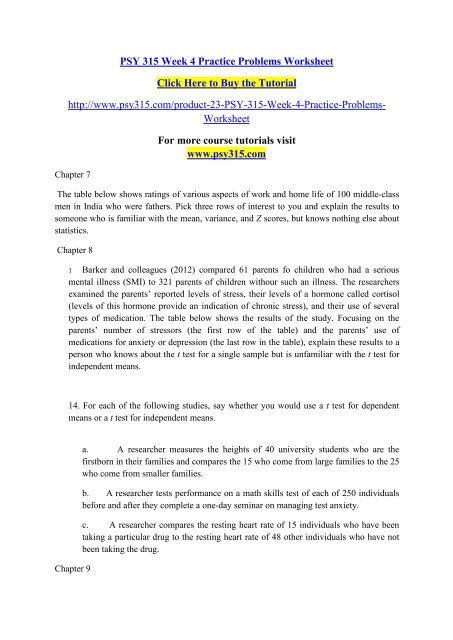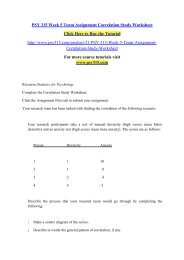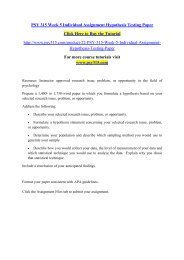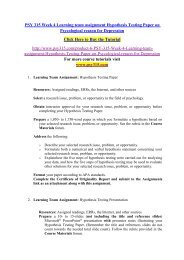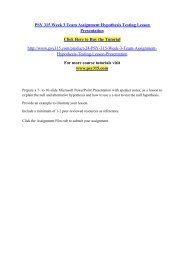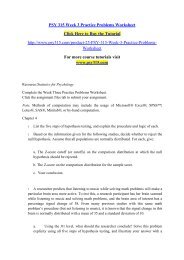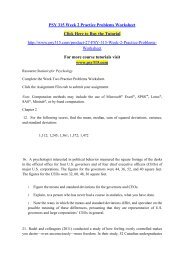PSY 315 Week 4 Practice Problems Worksheet
For more course tutorials visit www.psy315.com Chapter 7 The table below shows ratings of various aspects of work and home life of 100 middle-class men in India who were fathers. Pick three rows of interest to you and explain the results to someone who is familiar with the mean, variance, and Z scores, but knows nothing else about statistics. Chapter 8 1 Barker and colleagues (2012) compared 61 parents fo children who had a serious mental illness (SMI) to 321 parents of children withour such an illness. The researchers examined the parents’ reported levels of stress, their levels of a hormone called cortisol (levels of this hormone provide an indication of chronic stress), and their use of several types of medication. The table below shows the results of the study. Focusing on the parents’ number of stressors (the first row of the table) and the parents’ use of medications for anxiety or depression (the last row in the table), explain these results to a person who knows about the t test for a single sample but is unfamiliar with the t test for independent means.
For more course tutorials visit
www.psy315.com
Chapter 7
The table below shows ratings of various aspects of work and home life of 100 middle-class men in India who were fathers. Pick three rows of interest to you and explain the results to someone who is familiar with the mean, variance, and Z scores, but knows nothing else about statistics.
Chapter 8
1 Barker and colleagues (2012) compared 61 parents fo children who had a serious mental illness (SMI) to 321 parents of children withour such an illness. The researchers examined the parents’ reported levels of stress, their levels of a hormone called cortisol (levels of this hormone provide an indication of chronic stress), and their use of several types of medication. The table below shows the results of the study. Focusing on the parents’ number of stressors (the first row of the table) and the parents’ use of medications for anxiety or depression (the last row in the table), explain these results to a person who knows about the t test for a single sample but is unfamiliar with the t test for independent means.
Create successful ePaper yourself
Turn your PDF publications into a flip-book with our unique Google optimized e-Paper software.
<strong>PSY</strong> <strong>315</strong> <strong>Week</strong> 4 <strong>Practice</strong> <strong>Problems</strong> <strong>Worksheet</strong><br />
Click Here to Buy the Tutorial<br />
http://www.psy<strong>315</strong>.com/product-23-<strong>PSY</strong>-<strong>315</strong>-<strong>Week</strong>-4-<strong>Practice</strong>-<strong>Problems</strong>-<br />
<strong>Worksheet</strong><br />
Chapter 7<br />
For more course tutorials visit<br />
www.psy<strong>315</strong>.com<br />
The table below shows ratings of various aspects of work and home life of 100 middle-class<br />
men in India who were fathers. Pick three rows of interest to you and explain the results to<br />
someone who is familiar with the mean, variance, and Z scores, but knows nothing else about<br />
statistics.<br />
Chapter 8<br />
Barker and colleagues (2012) compared 61 parents fo children who had a serious<br />
mental illness (SMI) to 321 parents of children withour such an illness. The researchers<br />
examined the parents’ reported levels of stress, their levels of a hormone called cortisol<br />
(levels of this hormone provide an indication of chronic stress), and their use of several<br />
types of medication. The table below shows the results of the study. Focusing on the<br />
parents’ number of stressors (the first row of the table) and the parents’ use of<br />
medications for anxiety or depression (the last row in the table), explain these results to a<br />
person who knows about the t test for a single sample but is unfamiliar with the t test for<br />
independent means.<br />
14. For each of the following studies, say whether you would use a t test for dependent<br />
means or a t test for independent means.<br />
Chapter 9<br />
a. A researcher measures the heights of 40 university students who are the<br />
firstborn in their families and compares the 15 who come from large families to the 25<br />
who come from smaller families.<br />
b. A researcher tests performance on a math skills test of each of 250 individuals<br />
before and after they complete a one-day seminar on managing test anxiety.<br />
c. A researcher compares the resting heart rate of 15 individuals who have been<br />
taking a particular drug to the resting heart rate of 48 other individuals who have not<br />
been taking the drug.
An experiment is conducted in which 60 participants each fill out a personality test,<br />
but not according to the way the participants see themselves. Instead, 15 are randomly<br />
assigned to fill it out according to the way they think theur mothers see them (that is, the<br />
way they think their mothers would fill it out to describe the participants); 15 as their<br />
fathers would fill it out for them; 15 as their best friends would fill it out for them; 15 as<br />
the professors they know best would fill it out for them. The main results appear in Table<br />
9-17. Explain these results to a person who has never had a course in statistics.<br />
24. Rosalie Friend (2001), and educational psychologist, compared three methods of<br />
teaching writing. Students were randomly assigned to three different experimental<br />
conditions involving different methods of writing a summary. At the end of the two days<br />
of instructions, participants wrote a summary. One of the ways it was scored was the<br />
percentage of specific details of information it included from the original material. Here is<br />
a selection from her article describing one of the findings:<br />
The effect of summarization method on inclusion of important information was<br />
significant F(2, 144) = 4.1032, p < .019. The mean scores (with standard deviations in<br />
parantheses) were as follows: Argument Repetition, 59.6% (17.9); Generalization,<br />
59.8% (15.2); and Self-Reflection, 50.2% (18.0). (p.14)<br />
a. Explain these results to a person who has never had a course in statistics.<br />
b. Using the information in the preceding description, figure the effect size for the<br />
study.


